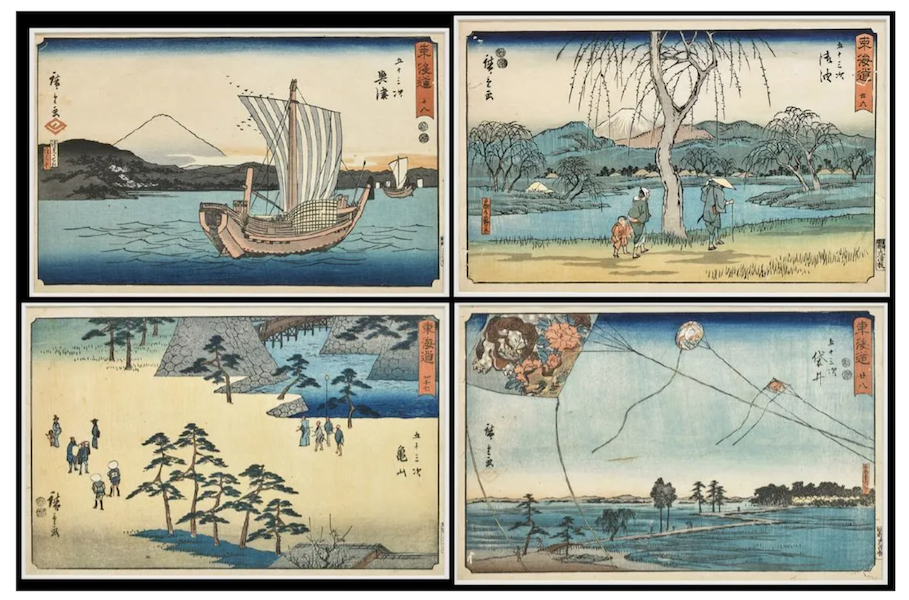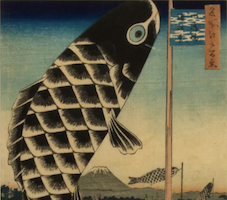
NEW YORK — Utagawa Hiroshige (1797-1858) is a celebrated Japanese artist whose reputation was hard-earned in his lifetime. Born in Edo, Japan as Tokutaro Ando, as a teenager he tried to study in the studio of the esteemed artist Toyokuni Utagawa, but was not accepted. He instead apprenticed with Toyohiro Utagawa in 1811 and was awarded his artist name, Hiroshige, in 1811. At this time, he was working at the local fire department, but quit to focus on his art. He pursued painting with a passion, but his talents went mostly unrecognized until he created a pioneering series of woodblock prints in 1832.
The series that changed everything for him was The 53 Stations of the Tokaido, in which he detailed a trek along the Tokaido road, the highway that connected Edo to Kyoto, and, up until the early to mid-19th century, was mostly used by the Japanese elite. “With the Tokugawa Shogunate relaxing centuries of age-old restrictions on travel, urban populations embraced travel art and Hiroshige Utagawa became one of the most prominent and successful ukiyo-e artists,” according to Ronin Gallery’s website. The term ukiyo-e translates to “pictures of the floating world” and describes a type of Japanese art popular from the 17th through 19th centuries. Its proponents created woodblock prints and paintings of quintessential subjects from history and literature; travel, nature and landscapes; as well as erotica, kabuki actors, sumo wrestlers and attractive women.
The Tokaido series was a hit in his lifetime and was later reprinted en mass. Early lifetime editions and woodblock prints from the series that have managed to retain bright colors will always be more valuable than posthumous iterations. Buyers should consult with a specialist to help decipher the seals on his prints to determine if a particular example is original or not.

A collection of 36 woodblock prints from the Tokaido series (the full run was 55 prints) published by Marusei realized $16,000 plus the buyer’s premium in January 2018 at I.M. Chait Gallery/Auctioneers.
Hiroshige’s woodblock prints have long appealed to those who appreciate fine art. The fundamental draw of his works lies in the lyrical style, which reportedly influenced the Impressionists and post-Impressionist artists in Europe from Toulouse-Lautrec to Van Gogh.
Arguably his best series of prints was 36 Views of Mount Fuji, begun circa 1832, showing the mountain that had, and continues to have, deep cultural and religious significance to the Japanese people. His views were portrayed from different viewing points, and in changing weather and light. A book containing all 36 prints sold for $15,000 in February 2020 at Revere Auctions.

Utagawa Hiroshige’s woodblock print book ‘36 Views of Mount Fuji,’ containing all 36 prints, brought $15,000 plus the buyer’s premium in February 2020. Image from the book courtesy of Revere Auctions and LiveAuctioneers.
Single prints are highly desirable with collectors but a triptych, which combines three prints, are even more so. A circa-1843 triptych of Japanese woodblock prints by Hiroshige showing a vision of Tiara no Kiyomori (1118-1181) attained $16,907 plus the buyer’s premium in October 2022 at Carlo Bonte Auctions. According to the Metropolitan Museum of Art, the ambitious and self-destructive Kiyomori was a tragic figure popularized in medieval warrior tales who died of fever during the Genpei War. “Hiroshige depicted him as haunted, but uncowed, by his past deeds, surrounded by eerie skull forms in a snowy garden,” the museum’s website reads.

Another famous series by the artist is One Hundred Famous Views of Edo, which highlighted landmarks such as Kyobashi Bridge and Edo Castle. It also featured important details and routines of daily life such as bamboo, plum gardens and fishing for carp. A group of six framed woodblock prints from this series made $11,000 plus the buyer’s premium in July 2022 at Clars Auction Gallery.
Snowy mountain scenes might be more representative of Japanese art than snowscapes are for New England paintings; a woodblock print of a snowy mountain gorge, probably Fuji River Gorge, earned $7,500 plus the buyer’s premium in June 2019 at CRN Auctions, Inc. The circa-1843 print was published by Sanoya Kihei and was offered framed under glass.

Hiroshige and other ukiyo-e artists known for their woodblock prints were almost like journalists in their day, documenting mundane and important moments of 17th-century life in Edo society, which was rapidly changing and modernizing at the time. Their artworks reached many and helped transform society itself. Today, art collectors clamor for these images of a bygone era that were initially not appreciated as fine art, but are now cherished and sought after.


